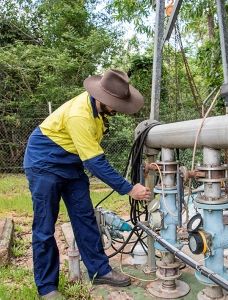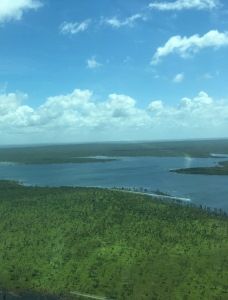Power and Water is responsible for delivering safe drinking water throughout a majority of the Northern Territory.
Sophisticated monitoring and treatment processes ensure your drinking water meets high standards.
We treat drinking water to limit exposure to disease-causing microorganisms. This includes disinfecting the water with chlorine at many points from storage, to supply and to you.
As well as disinfecting your water, we may also add fluoride to meet Department of Health requirements.
Drinking water quality reports
Our Drinking Water Quality Reports are an open and transparent record of Power and Water’s service delivery across the Northern Territory, under the framework of the Australian Drinking Water Guidelines.
Power and Water adopts the multiple barrier approach in the framework to robustly control drinking water quality. These reports describe the approach used and the water quality results obtained.
Water treatment methods
The processes used to remove contaminants and improve and protect water quality are similar around the world.
Treatment methods used depend on the water quality issues. Chlorine is the preferred disinfection treatment as it’s simple to use, destroys pathogens and provides protection throughout distribution.
The Department of Health provides a list of the harmful organisms we are trying to prevent.
Remote water treatment
A different mix of treatment processes apply in remote communities. These processes involve treating raw water before disinfection and distribution. Treatment methods include filtration and aeration.
Read more about remote water sources
The most widely applied water treatment is a combination of some or all of the following:
During coagulation, a chemical, usually alum, is added to help bacteria and small solid particles stick together. Larger particles then settle in-situ, which we can easily remove.
Mechanical settling basins called clarifiers use gravity to separate solid particles and remove colour.
Filtration removes particles as water passes through filters or membranes. The method varies between treatment plants:
- gravity media filtration uses filters containing layers of sand
membrane filtration uses semi-permeable membranes with billions of microscopic pores.
Chlorine or ultraviolet light destroys disease-causing bacteria. Chlorine provides constant, effective protection from the treatment plant to the tap. This disinfection is especially useful in long pipelines and high water temperatures. We use chlorine for disinfection purposes in all drinking water supply systems. The amount of chlorine added is relative to the purity of the water and is typically less than one milligram per litre.
Fluoride naturally occurs in our water or, where possible is added in small amounts, less than one milligram per litre, to help prevent tooth decay. Fluoridation is recommended by the Department of Health.
Lime, caustic soda or soda ash is added to correct very soft natural water. The minerals in lime also help prevent household pipes and fittings from corroding.
Water sources
Major centres
| Centre | Surface water | Groundwater |
|---|---|---|
| Darwin | √ Darwin River Reservoir | √ Howard East Borefield |
| Katherine | √ Katherine River Donkey Camp Weir | √ |
| Tennant Creek | √ Cabbage Gum / Kelly Well Borefields | |
| Alice Springs | √ Roe Creek Borefield | |
| Yulara | √ |
Minor centres
| Centre | Surface water | Groundwater |
|---|---|---|
| Adelaide River | √ | |
| Batchelor | √ | |
| Borroloola | √ | |
| Cox Peninsula | √ | |
| Daly Waters | √ | |
| Elliott | √ | |
| Gunn Point | √ | |
| Kings Canyon | √ | |
| Larrimah | √ | |
| Mataranka | √ | |
| Newcastle Waters | √ | |
| Pine Creek | √ | |
| Timber Creek | √ | |
| Ti Tree | √ |



